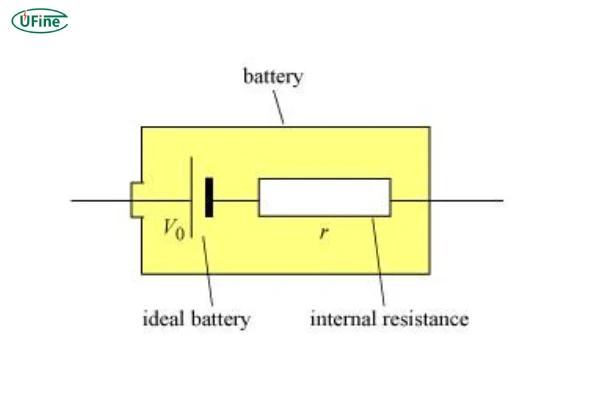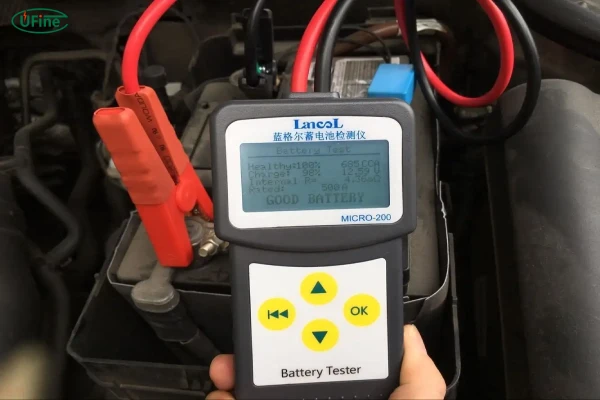
- Part 1. What is internal resistance in a lithium battery?
- Part 2. How does internal resistance affect battery performance?
- Part 3. How to measure lithium battery internal resistance?
- Part 4. Choosing the right measurement method
- Part 5. Key considerations when measuring internal resistance
- Part 6. Conclusion
Internal resistance is an essential factor in determining the performance, efficiency, and lifespan of lithium batteries. While many users focus on capacity and voltage when assessing batteries, internal resistance plays a significant role that can’t be overlooked. In this article, we’ll explore what internal resistance is, how it impacts lithium battery performance, and the best methods for measuring it. Understanding this concept is crucial whether you’re designing, testing, or troubleshooting batteries.
Part 1. What is internal resistance in a lithium battery?
In simple terms, internal resistance refers to the opposition to the flow of electrical current inside the battery. Just like any electrical circuit, a battery has resistance that slows down or limits the movement of charge. This resistance can affect various aspects of battery behavior, such as its efficiency and its ability to deliver power when needed.
Internal resistance in lithium batteries is made up of two primary components: ohmic resistance and polarization resistance.
-
Ohmic Resistance: This type of resistance is caused by the physical materials inside the battery. These materials include the electrodes, electrolyte, and separator. The resistance here is constant and does not vary with current or temperature, and it is mainly a result of the materials’ inherent properties.
-
Polarization Resistance: Polarization resistance, on the other hand, is more dynamic. It occurs due to the electrochemical reactions inside the battery, which create a temporary barrier (polarization) that impedes the flow of electrons. This resistance can vary depending on factors like the charge or discharge rate, the battery’s age, and temperature.
Understanding these two components of internal resistance helps explain how and why it affects battery performance.
Part 2. How does internal resistance affect battery performance?
Now that we know what internal resistance is, let’s take a closer look at how it impacts battery performance.
1. Power Output
Batteries with lower internal resistance can provide higher output currents. This means the battery can deliver more power to devices without significant voltage drops. This is especially important in high-demand applications like power tools, electric vehicles, and smartphones, where a high power output is crucial.
Batteries with higher internal resistance, on the other hand, struggle to deliver the same power. The higher the resistance, the more energy is lost as heat. This heat can damage the battery and reduce its lifespan.
2. Charging and Discharging Efficiency
Internal resistance also plays a key role in the efficiency of both charging and discharging cycles.
-
Charging Efficiency: During charging, a battery with higher internal resistance will have higher energy losses due to heat generation. This means that more energy is wasted in the form of heat, and less energy goes into actually charging the battery. This can also cause the battery to heat up more quickly, which is undesirable.
-
Discharging Efficiency: When discharging, a battery with high internal resistance will experience significant voltage drops, reducing the amount of power available for your device. In applications like wearables or electric cars, this can lead to less reliable performance and shorter usage times between charges.
3. Battery Lifespan
One of the most important impacts of internal resistance is on the battery’s overall lifespan. Higher internal resistance means the battery works harder, generates more heat, and deteriorates faster. Over time, this can cause irreversible damage, leading to shorter battery life and fewer charge-discharge cycles.
In contrast, a battery with low internal resistance is more efficient, generates less heat, and tends to last longer, providing a better return on investment in the long run.
Part 3. How to measure lithium battery internal resistance?
Now that we understand how internal resistance affects performance, it’s important to know how to measure it. Measuring internal resistance is critical for assessing the health of the battery, evaluating its performance, and diagnosing potential issues. There are several methods used to measure internal resistance, ranging from simple to more complex.
DC Resistance Measurement Methods
-
Short-Circuit Current Method
In this method, the battery is briefly short-circuited, and the maximum current and voltage drop across the battery terminals are measured. The internal resistance is then calculated using Ohm’s law:Where:
- is the internal resistance,
- is the voltage drop,
- I is the current.
Advantages:
- It’s simple and quick.
- Can be used for a fast, rough estimate of internal resistance.
Disadvantages:
- The process can potentially damage the battery due to high short-circuit current.
- The measurement is affected by contact resistance, which can skew the results.
-
Pulse Current Method
This method involves applying a brief high-current pulse to the battery and measuring the voltage change before and after the pulse. This allows for a more controlled measurement of internal resistance.Advantages:
- This method causes minimal damage to the battery.
- It provides more accurate and stable results than the short-circuit method.
Disadvantages:
- Requires more sophisticated equipment for precise control.
- Can still be influenced by external factors such as battery temperature.
AC Resistance Measurement Methods
-
AC Injection Method
This method involves injecting a small AC signal into the battery and measuring its voltage response. The internal resistance is derived by calculating the ratio of voltage to current.Advantages:
- This method provides high accuracy and is gentle on the battery.
- It works well for measuring resistance without causing significant impact on the battery’s state.
Disadvantages:
- The equipment required for this method is more complex and expensive.
- It may require calibration to ensure accurate results.
-
Electrochemical Impedance Spectroscopy (EIS)
This is one of the most advanced methods. It applies a range of AC signals at various frequencies to the battery and measures how the battery responds. This provides a full impedance spectrum, which can be analyzed to calculate internal resistance and other important parameters such as charge transfer resistance and reaction kinetics.Advantages:
- EIS provides a deep insight into the battery’s internal processes.
- It can give a detailed profile of the battery’s health and performance.
Disadvantages:
- The method requires specialized equipment and significant expertise to interpret the results.
- Measurement can be time-consuming and expensive.
Part 4. Choosing the right measurement method
With various measurement methods available, it’s important to select the one that best suits your needs.
Quick Evaluation: DC Methods
If you need a fast and simple evaluation of internal resistance, DC methods like the short-circuit current or pulse current method are suitable. These are commonly used in mass production environments for preliminary testing.
In-depth Analysis: AC Methods
For more accurate results and a detailed analysis of battery health, AC methods, especially Electrochemical Impedance Spectroscopy (EIS), are the best choice. These methods are commonly used in research, development, and high-quality control applications where precision is critical.
At Ufine Battery, as a leading lithium battery manufacturer in China, we take great care to minimize internal resistance in our products. Through advanced production processes and the use of high-quality materials, we ensure that our batteries maintain low internal resistance, which results in better performance and longer life for our clients.
Part 5. Key considerations when measuring internal resistance
To ensure accurate and reliable measurements, there are several key factors to keep in mind:
-
Environmental Conditions
- Temperature: Internal resistance is highly sensitive to temperature, so it’s important to control the testing environment. Conducting tests at different temperatures can give insight into how the battery behaves under varying conditions.
- Humidity: Excess humidity can affect both the measurement equipment and the battery itself, leading to inaccurate results. Keep the environment dry to minimize errors.
-
Battery State
- Charge Level: Make sure to test the battery at the same charge state for consistency. Different charge levels can result in varying internal resistance.
- Rest Time: Allow the battery to rest before measuring to ensure its internal state has stabilized.
-
Equipment Calibration
Regularly calibrate your testing equipment to maintain measurement accuracy. Also, ensure that the equipment used is of the required precision for your needs. -
Contact Resistance
Make sure that the battery terminals and the testing equipment are in good contact. Any corrosion or dirt on the terminals can lead to inaccurate results.
Part 6. Conclusion
In conclusion, internal resistance is a critical factor in lithium battery performance. Whether you’re designing batteries, testing their health, or troubleshooting, understanding and measuring internal resistance is essential. While methods like DC measurements are fast and easy, more complex AC methods, such as EIS, offer greater accuracy and deeper insights into battery health. By selecting the right measurement method and paying attention to environmental factors, you can ensure that your batteries perform at their best and last longer.
At Ufine Battery, we take pride in our expertise as a custom lithium battery manufacturer. By carefully managing internal resistance through innovative manufacturing techniques, we ensure that our batteries provide reliable, efficient performance over their entire lifespan. Understanding and reducing internal resistance is at the heart of our commitment to high-quality, durable lithium batteries for our clients.
Ultimately, understanding internal resistance can help you improve battery design, enhance performance, and prolong the life of your devices, from electric vehicles to wearables and beyond. So, next time you’re working with lithium batteries, don’t forget the importance of internal resistance—it’s more than just a number, it’s a key to optimal battery performance!
Related Tags:
More Articles

Battery Load Test: A Comprehensive Guide
Step-by-step battery load test guide for car, solar & industrial use. Learn how to load test a battery, interpret voltage charts, and avoid common mistakes.
The Comprehensive Guide to Battery Balancing and Battery Balancer
Discover how battery balancers improve lithium battery performance, lifespan, and safety. Learn types, functions, and tips to choose the right balancer.
What Is the Best Voltage for a Chainsaw Battery?
Compare 12V-80V chainsaw batteries for light pruning, medium firewood, and professional cutting. See best battery chainsaw with runtime charts and safety tips.
Lithium VS. Alkaline Batteries: A Comprehensive Comparison
Lithium batteries last 3–7× longer than alkaline and perform better in cold weather. Compare lifespan, cost, safety, and best uses to choose the right battery.
Comparing Lithium-Sulfur and Lithium-Ion Batteries: Which is Right for You?
Compare lithium-sulfur (Li-S) and lithium-ion batteries on energy, lifespan, cost, safety, and applications. Best choice for drones, EVs, and electronics.




